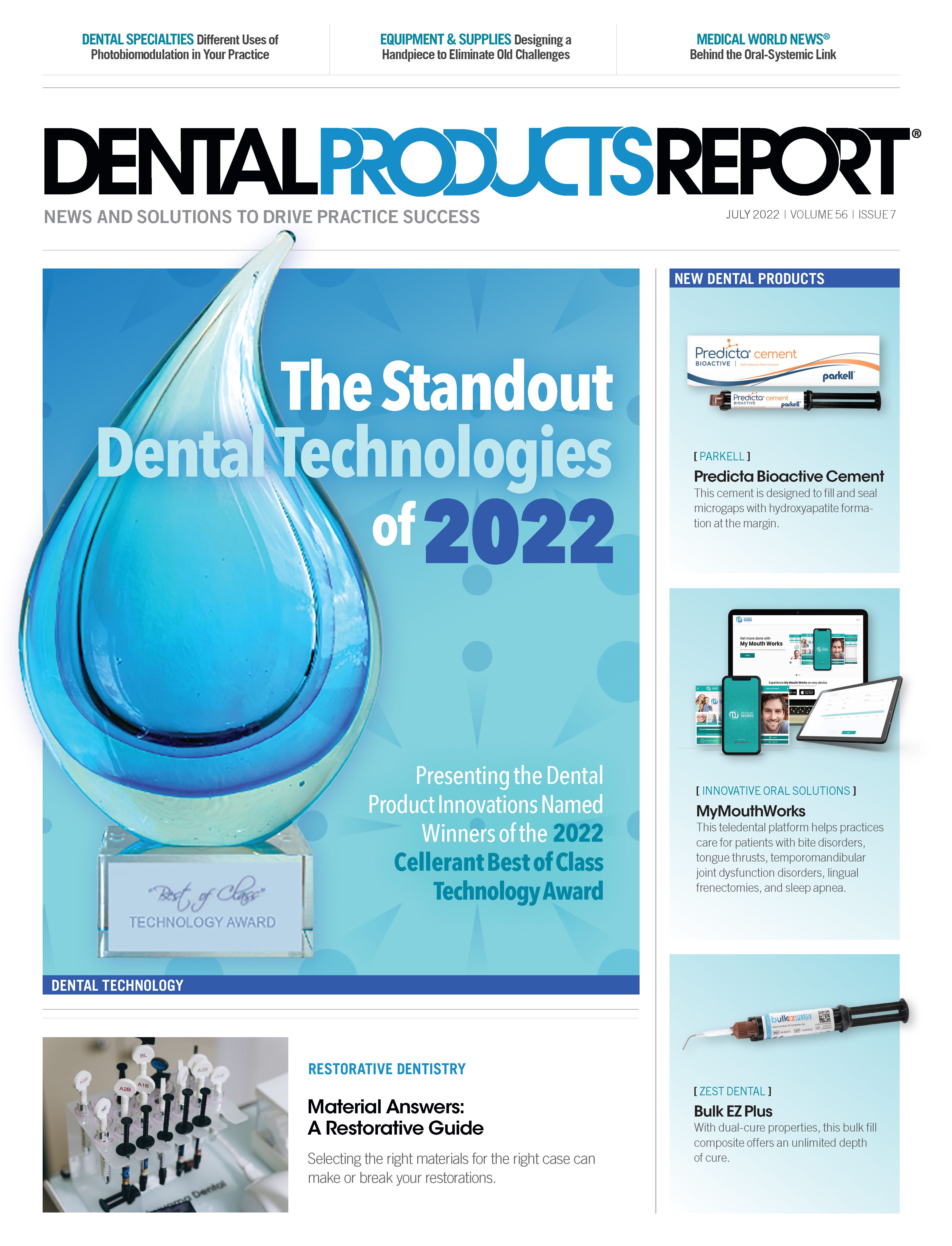Warming composite to assist clinicians in seating restorations, placing, and manipulating composites has been in regular use since the 1980s.1 AdDent, Inc, has a long history in developing warming technology to improve clinical outcomes and provide a predictable way of effortlessly placing composite restorations.
As composite resin technology has improved with increased strength, higher filler content, lower volumetric shrinkage, and better polishability, composite handling has become more challenging. The improvements made in composite resin technology have produced products that are far stiffer than previous generations, which has created a conundrum for clinicians.
Should they continue to use inferior, older technology with easier handling or move to a new composite with dramatically improved characteristics but with significant challenges when placing the restoration because of significantly higher stiffness? Fortunately, the answer does not have to be either one or the other. Clinicians can incorporate composite warming technology and pair that with a modern, nano-filled composite of their choice, which will dramatically lower the viscosity of the composite with higher filler loading, making it easy to place and manipulate.
The Science of Warming Composite
Composite warming was first discussed in literature in the early 1980s.2 These articles discuss the physical properties and changes that occurred with warming composites. From these articles, many clinical techniques were developed using the concept of warming composite.1 Warmed composites have an increase in kinetic energy and great movement compared with room-temperature composites. This phenomenon leads to heated composites experiencing greater monomer conversion and increased depth of cure.3,4 Examination of margin adaptation has demonstrated that heated composites lead to better marginal adaptation than those restorations placed at room temperature.5 Muñoz et al demonstrated that both hybrid and nanohybrids had significantly increased surface hardness and depth of cure when
composite heating was utilized.6 Heated composites provide several advantages to clinicians and have the potential to dramatically improve clinical outcomes.
Indication and Uses of Compex HD Composite Warming Technology
- Warming conventional composites for all anterior and posterior direct restorations
- Warming flowable composites for use as a liner in various situations
- Warming flowable and conventional composites for injection molding techniques
- Warming composite resin to be used as a resin cement when placing indirect restorations
Traditional Composite Warming Technology Compared With Compex HD
AdDent has a long history of producing composite warming technology, with many substantial improvements over the past several decades, including the Calset Composite Warmer (Figure 1). Traditionally, all composite warmers were stand-alone technologies that utilized a warming device to heat composites to 155 °F. These systems heated composite by warming a traditional composite gun preloaded with the selected composite. Although quite effective, once the gun leaves the warming device, the composite begins to lose heat immediately.7
Between each incremental layer of composite, the gun should be returned to the warmer to maintain its temperature at 155 °F. This problem has been eliminated with the creation of AdDent’s Compex HD composite warming gun (Figure 2). This wireless, rechargeable composite gun warms composite in 1 to 2 minutes and can dispense approximately 100 compules before the unit needs to be recharged. The unit is extremely lightweight and possesses an ergonomic design, making composite placement easy and efficient.
Catapult Education’s Evaluation
In a recent evaluation of Compex HD with Catapult Education, Compex HD was evaluated by 8 clinical evaluators, 7 of which had extensive experience with composite warming technology and techniques. A total of 100 patients were treated using the Compex HD, with more than 150 restorations being placed. All evaluators (100%) said they would use the Compex HD composite warming device in all restorative and composite procedures, 87% were “very satisfied” with the performance and construction of the warmer, and the remaining 13% were “satisfied” with its performance and construction. The evaluators felt the Compex HD greatly assisted in the placement of composite, making the material far easier to manipulate. AdDent’s Compex HD was awarded the Catapult Education Vote of Confidence, which is a demarcation reserved for only those products that receive overwhelmingly positive reviews and feedback.
Clinical Case
This 24-year-old patient presented with fractured incisal edges of #8 and #9, which occurred during a traumatic accident as an adolescent (Figure 3). His desire was to have the incisal edges of his front teeth restored as conservatively as possible without sacrificing an esthetic outcome. With this in mind, the decision was made to utilize a diagnostic wax-up and corresponding incisal edge putty matrix to aid in the placement of Class VI composite resin restorations (Figure 4).
Prior to anesthesia and tooth preparation, the putty matrix was tried in to confirm proper seating and fit, and composite shades were selected. Teeth #8 and #9 were prepared using a pointed diamond bur, establishing an irregular bevel along the incisal ¹/3 of each incisor (Figure 5). A Mylar strip was placed in the putty between #8 and #9 to prevent bonding the teeth together. Using the Compex HD, the lingual incisal portion of the putty was loaded with A1 composite (Mosaic; Ultradent Products, Inc) and placed under an orange protective shield. The incisal edges of both incisors were etched with 37% phosphoric acid (Ultra-Etch; Ultradent Products, Inc) (Figure 6).
About Catapult
Catapult is an organization that consists of more than 50 clinicians spread throughout Canada and the United States. As a company, manufacturers pay a fee for their product to be evaluated and what we deliver are truthful, independent answers from surveys that we develop with them. We have had many products that have either had to be altered before hitting the market or simply never arrived because of our openly honest evaluations. In this way, Catapult assists the manufacturer to avoid potentially releasing a faulty product, or simply a product that needs refinement. Lastly our clients are omnipresent in the industry, small to large, no favoritism, simply reviewing the latest products in our practices.
A bonding agent was applied to all etched surfaces and cured with a LED curing light (Figure 7). The preloaded putty matrix was carried to the mouth and placed to deliver the lingual portion of the composite to the prepared teeth. Excess material was cleared from the facial aspect of the restorations to provide room for the enamel veneering composite (Figure 8). This lingual layer of composite was cured using an LED curing light. The lingual matrix was removed, leaving the Mylar strip in place between #8 and #9.
Using the Compex HD, Enamel Neutral composite (Mosaic; Ultradent Products, Inc) was placed on the facial aspect of #8 and #9 (Figure 9). The composite was quickly manipulated into place using a composite placement instrument (Figure 10) and cured using an LED curing light (Figure 11). The restorations were then finished using interproximal finishing strips (Figure 12) and polished using the A.S.A.P. polishing system (Clinician’s Choice Dental Products, Inc). The completed restorations (Figures 13 and 14) created a beautiful result and were made simple to place by using the Compex HD by AdDent.
References
1.Lopes LCP, Terada RSS, Tsuzuki FM, Giannini M, Hirata R. Heating and preheating of dental restorative materials-a systematic review. Clin Oral Investig. 2020;24(12):4225-4235. doi:10.1007/s00784-020-03637-2
2.Bausch JR, de Lange C, Davidson CL. The influence of temperature on some physical properties of dental composites. J Oral Rehabil. 1981;8(4):309-317. doi:10.1111/j.1365-2842.1981.tb00505.x
3.Daronch M, Rueggeberg FA, De Goes MF, Giudici R. Polymerization kinetics of pre-heated composite. J Dent Res. 2006;85(1):38-43. doi:10.1177/154405910608500106
4.Trujillo M, Newman SM, Stansbury JW. Use of near-IR to monitor the influence of external heating on dental composite photopolymerization. Dent Mater. 2004;20(8):766-777. doi:10.1016/j.dental.2004.02.003
5.Wagner WC, Asku MN, Neme AM, Linger JB, Pink FE, Walker S. Effects of pre-heating resin composite on restoration microleakage. Oper Dent. 2008;33(1):72-78. doi:10.2341/07-41
6.Muñoz CA, Bond PR, Sy-Muñoz J, Tan D, Peterson J. Effect of pre-heating on depth of cure and surface hardness of light-polymerized resin composites. Am J Dent. 2008;21(4):215-222.
7.Daronch M, Rueggeberg FA, Moss L, de Goes MF. Clinically relevant issues related to preheating composites. J Esthet Restor Dent. 2006;18(6):340-351. doi:10.1111/j.1708-8240.2006.00046.x

